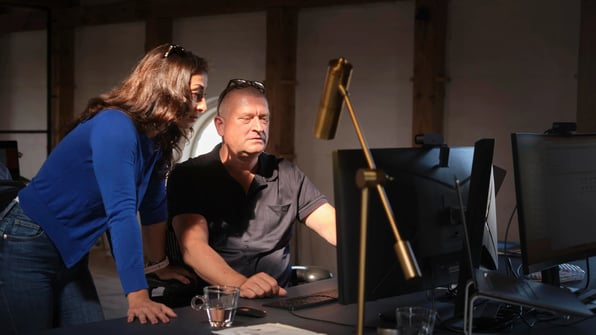The Inner Game of Strategy Execution

As a leader, you can't achieve your strategic goals by executing all strategic initiatives yourself. You rely on your teams and their ability to perform. To get teams to perform at their peak, you must trust them to do things without your interference, but you must also understand the inner game that goes on no matter what big tasks people are facing.
If you as a manager want to avoid becoming a bottleneck in your company, you need to flatten the organization. This implies a delegation of responsibility and authority and thus greater autonomy and freedom—for example in identifying and carrying out initiatives related to strategy execution. The ability to collaborate is more crucial than ever to succeed with your strategy. Therefore, as a leader, you must acquire the skills needed to unlock the inner dynamics of the team, develop fruitful collaboration, and create effective teams focused on the success of the business—because no collaboration is more effective than a highly skilled team that’s aligned in its direction and goals.
In addition to overall improved efficiency, team collaboration brings a greater degree of commitment to shared strategic decisions, and thus a sense of ownership by each team member in relation to shared goals, plans, and actions. A well-developed, team-based organizational framework also increases the organization’s learning capacity, and thus its effectiveness. Your organization becomes more agile and resilient in a challenging marketplace.
The internal argument with yourself
No matter what game you’re playing (including strategy execution), there's always an inner game being played in your mind simultaneously. Ask any experienced chess player for proof of this claim. Your awareness of this inner game can make the difference between success and failure. If we’re to succeed as a team and as individuals, we need to be in control of our inner game. It’s not always our competitors who are the biggest obstacles to our success; it can also be the battle within ourselves through our inner dialogue.
Most people undoubtedly know this for themselves. There are situations where you have an internal loud argument with yourself. It's as if two people are having a merry discussion inside your head. One of them is saying: You can do it, just get on with it! while the other might say No, remember to follow the instructions, or Be careful not to make mistakes! or Analyze the facts first, or It can't be done, Others are much better, etc. In many cases, the internal discussion overshadows the task at hand—so you lose focus and your performance drops. The same is true for a team.
The critical variables
The critical factors in any collaboration are the external and internal considerations that make the difference between success and failure for the team, its members, and the collaboration itself. We call them critical variables because they can bring about a tipping point. Critical variables create change and very small things can cause very big changes. A tipping point occurs when you identify the critical variables that tip the scales your way. Then the possibilities become almost limitless, and the obstacles are reduced to mere bumps in the road.
In his 2000 book The Tipping Point: How Little Things can Make a Big Difference, Malcolm Gladwell defined this concept. In the mental context, it's about finding the small change that will make a big impact. For example, changing one single factor might lessen or eliminate disorientation, leaving you with uncompromised focus.
Language, for example: an otherwise harmless statement might include one emotionally charged word that can instantly change the climate in the room from harmonious to conflicted—or the opposite. Participation in a community event might prompt team members to put aside self-interest in favor of community goals. A new trend might, due to a single incident, suddenly be considered just common sense by the team.
A high-performing collection of people
The task of the organizational leader who wants to succeed with strategy execution is first and foremost to identify the main critical variables for each team to succeed. The question then is how to identify exactly which critical variables make the difference. It is at once simple and complex. The focus must be on the critical variable(s) that can trigger the greatest impact in the given situation. Success is rooted in detail—in the ability to capture exactly what needs attention.
T.E.A.M.—Together Each Achieves More. We don’t know who invented the acronym, but it makes a lot of sense to us. We define a team as a high-performing collection of people with a clear common goal and identity. The members of high-performing teams depend on (and can effectively utilize) each other's resources and skills.
Performance is an expression of the potential the team is able to realize in a given situation. Performance is the critical mass of skills and competencies the team can mobilize to perform a specific task..png?width=642&name=Graphics%20for%20Blogs%20(4).png)
Skill is a critical variable
We tend to look for external reasons for our own suboptimal performance, but the most critical obstacles are typically closer to home. For example, a football team may hit its own peak of performance—but still lose the match because the other team displayed a higher level of skill. Skill encompasses both professional competencies and personal qualities such as courage, determination, will, and so on.
A good performance doesn’t guarantee good results, but all efforts should typically be followed by the question: What can we do better next time? The skill level of the team as a whole is a critical variable.
Every achievement is a series of demonstrations of skill. In a team, performance is a complex chain of actions that must combine to produce a top performance. In practice, this means that each team member should realize their own full potential and demonstrate optimal professional skills. After that, the ability of team members to work together will determine whether individual performance coalesces into collective excellence.
Optimizing inner game performance
The overall critical variable in the Inner Game is optimized inner performance, with the sole aim of improving overall team performance. Team members must therefore work on their own learning, based on their experiences and the team's self-awareness. Team members can then best use each other's potentials and strengths to achieve common goals.
It's simple, and should be easy to do. The challenge is when harmful assumptions and beliefs drive team members’ behavior, thus influencing the team as a whole. Focusing on the task at hand and maintaining transparency are only part of the answer. A well-informed manager is aware of any detrimental attitudes (e.g., toward technology) and certainly toxic behavior (such as undercutting team members). A frank conversation may be in order; as unpleasant as it is, dealing effectively with destructive behavior should be a priority.
Inner Game is based on the idea that experience is the best teacher. We don’t use classroom-type instructions when the team is learning from its experiences; rather, we use a coaching model. To learn how to play the Inner Game, you need a non-judgmental mindset.
The dialogue between Self 1 and Self 2
When collaborating to achieve a strategic objective, our ability to work with ourselves may be the first step toward success. Also, personality assessments and the need to adapt effectively to a team environment will initiate an inner dialogue—one that may help or hinder the team’s performance. The better we are at managing this Inner Game and non-judgmentally observing the critical variables, the greater our chance of peak performance.
When we identify the critical variables and/or tipping point and focus accordingly, we avoid getting in our own way—and that of the team as a whole. This inner dialogue is between Self 1 (the judging self) and Self 2 (the intuitive self).
Self 1, the judgmental and narrative self, is like a mentor or our parents. It wants to tell us what’s right and wrong and order us around. Self 1 is critical, analytical, and skeptical—and tends to want to control Self 2.
Self 2, intuitive and non-judgmental, is also the first to react to changes in the environment. This happens in the central nervous system in a split second.
.png?width=644&name=Graphics%20for%20Blogs%20(5).png)
Self 1 and Self 2 in the team
The team must be aware of whether there are too many Self 1s offering input into discussions. If this is the case, the team as a whole might become too Self 1 oriented, judging and condemning everything, thus creating a very self-critical and destructive learning environment. This will undermine the team's self-confidence and the fear of making mistakes will become paralyzing.
A healthier and more productive collaborative environment incorporates each team member’s Self 2. Teams working in the spirit of Self 2 create a trusting vs. controlling culture. The team constantly works to stay on top of changes in the environment, and it acts accordingly. A healthy balance between Self 1 and 2 encourages better focus and gives the best results.
.png?width=644&name=Graphics%20for%20Blogs%20(2).png)
Programming Self 2
A non-judgmental learning environment results in far fewer blockages and obstacles. Working with awareness allows for sharper focus. Self 2 teams learn by working within present circumstances, always assessing what should be done differently next time. In Inner Game, the team development environment consists of testing and self-correction. This requires a keen awareness, but in turn supports greater focus on the goal.
Once a non-judgmental consciousness is established, Self 1 can now help Self 2. Self 1 must simply program Self 2 with positive signals, impressions, feelings, and experiences. Top-performing teams let Self 1 program Self 2; Self 1's primary role is to set non-judgmental goals for Self 2—and then let Self 2 perform in peace. The team can then work in a structured way, independent of all assumptions.
The non-judgmental consciousness is the key to team dynamics
Acting and learning purposefully first requires our awareness. What drives us, and what drives others on the team? What is real and what is distorted by our assumptions and beliefs? This is a prerequisite if the team is to learn from its experiences.
When the team works with a non-judgmental attitude, it doesn’t label things right/wrong or good/bad. It works on becoming aware of what is—and nothing else. This means observing one's own and others' feelings and actions, and asking questions to better understand them.
.png?width=2240&name=Graphics%20for%20Blogs%20(3).png)
Members of a Self 2 team put the judging self on hold so it doesn’t pollute observations with erroneous assumptions and beliefs. Successful strategy execution is about unlocking the potential of the team—and for that you have the right tool to help you with that. Learn how can your team be aligned in strategy execution in a free demo.










